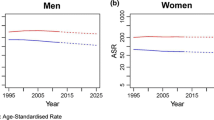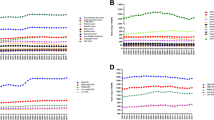Abstract
Objective
Any fall-off in the age-specific cancer incidence curve in oldest age groups may be suggestive of under-ascertainment. This article introduces a correction method for under-ascertainment of cancer cases in the very elderly (aged 75+).
Methods
Corrected age-specific rates for a certain cancer are calculated by summing the age-specific rates of that cancer for two lower age groups multiplied by a corresponding coefficient from an external reference cancer registry (sex-, site-, and age-specific coefficients from the Finnish Cancer Registry, a nation-wide population-based registry with high data validity). In order to examine this new method, Lithuanian Cancer Registry data for the period 1993–97 was chosen as an example.
Results
Age-specific incidence curves of cancers in both sexes and most of cancer sites in Lithuania demonstrated the presence of under-ascertainment in the oldest age groups (over 75). Comparison of the corrected incidence rates for 1995 with the original ones showed that without correction for under-ascertainment, crude rates (and consequently number of new cases) were underestimated by around 10%. Underestimation for the year 2050 in Lithuania was ∼20%. Depending on cancer site and sex, the percentage of underestimation varied substantially.
Conclusion
In many cancer registries, after correction for under-ascertainment in elderly age groups, the estimates of number of new cases and incidence rates increase. With respect to prepare future projections of incidence, when the effects of an aging population need to be taken into account, accurate age-specific rates in the upper age groups are important. Without correction, cancer occurrence measures may be substantially underestimated, which may lead to inadequate resource allocations for cancer control.





Similar content being viewed by others
References
Parkin DM, Chen VW, Ferlay J, Galceran J, Storm HH, Whelan SL (1998) Completeness. Comparability and quality control in cancer registration. IARC Press, Lyon, p. 38
Parkin DM, Whelan SL, Ferlay J, Teppo L, Thomas DB (2002) Cancer incidence in five continents. IARC Press, Lyon
Teppo L, Pukkala E, Lehtonen M (1994) Data quality and quality control of a population-based cancer registry. Experience in Finland. Acta Oncol 33(4):365–369
Jensen OM, Parkin DM, Maclennau R, Mair CS, Skeet RG (1991) Cancer registration principles and methods. IARC Press, Lyon
Acknowledgment
Authors would like to thank Dr D. Maxwell Parkin for his comment which led to the maturation of this method.
Author information
Authors and Affiliations
Corresponding author
Rights and permissions
About this article
Cite this article
Fallah, M., Kharazmi, E. Correction for under-ascertainment in cancer cases in the very elderly (aged 75+): external reference method. Cancer Causes Control 19, 739–749 (2008). https://doi.org/10.1007/s10552-008-9136-7
Received:
Accepted:
Published:
Issue Date:
DOI: https://doi.org/10.1007/s10552-008-9136-7




